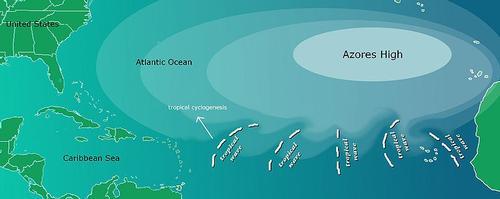AZORES
Climate and Weather

Climate and Weather
Popular destinations PORTUGAL
| Algarve | Azores | Costa de lisboa |
| Costa verde | Madeira |
Climate and Weather

Due to the dampening influence of the Gulf Stream, the Azores have a moderate climate all year round with few temperature differences, but especially in the summer months of August and September it can be oppressive heat due to the high humidity. Maximum daytime temperatures and nighttime temperatures are about 5°C lower in both summer and winter, from 14°C (9°C at night) in the coldest month of February to 27°C (22°C at night) ) in the hottest month of August.
The seawater temperature is also influenced by the Gulf Stream running along the south of the Azores, and is between 17 and 23°C. On average there are about five to six hours of sunshine in the winter and eleven to twelve hours in the summer. The southern sides of the islands are generally a bit warmer and sunnier than the northern parts and the humidity is also a bit higher there. The islands in the east of the archipelago are the warmest, the islands in the west have lower temperatures due to the stronger wind. Santa Maria, the southernmost island of the Azores, is the island with the most sunshine and is therefore not called 'Ilha do Sol' for nothing.
Rain can fall all year round, but more and more often in the winter months December and January, but also in March it can still rain regularly. Characteristic of the climate in the Azores is the wide variety of weather conditions, sun and rain, in a short period. The average rainfall per year is between 1000 and 1600 mm. The island with the least rainfall is Graciosa, most rainfall falls on the western islands of Corvo and especially Flores (1600 mm).
The mountains in the Azores are often shrouded in mist, so it is better to stay on the coast. In winter, stormy depressions sometimes cause extremely bad weather with large amounts of rain. These showers can be so severe that landslides occur, such as in 2010 on the island of Flores, where the town of Fajãzinha was completely cut off from the outside world. Atop the highest mountain in the Azores, Montanha do Pico, in winter it often freezes and snow can fall.
Weather table Ponta Delgada on São Miguel Island
July
| maximum day temperature | maximum night temperature | water temperature | hours of sunshine per day | rainy days per month | |
| January | 14°C | 8°C | 18°C | 5 | 11 |
| February | 15°C | 8°C | 17°C | 6 | 8 |
| March | 17°C | 10°C | 17°C | 6 | 11 |
| April | 20°C | 12°C | 17°C | 9 | 7 |
| may | 21°C | 13°C | 18°C | 10 | 7 |
| June | 25°C | 15°C | 20°C | 11 | 2 |
| 27°C | 17°C | 21°C | 12 | 1 | |
| August | 28°C | 17°C | 22°C | 11 | 1 |
| September | 26°C | 17°C | 23°C | 9 | 4 |
| October | 22°C | 14°C | 22°C | 8 | 7 |
| november | 17°C | 11°C | 20°C | 6 | 9 |
| december | 15°C | 9°C | 19°C | 5 | 11 |
In the weather talk on television, the so-called Azores high is often mentioned. a subtropical high pressure area around the Azores. The Azores high is created by the exchange of heat between the North Pole, the South Pole and the tropics.
Sources
BBC - Country Profiles
CIA - World Factbook
Elmar Landeninformatie
Lipps, Susanne / Azoren
ANWB
Marsh, Terry / Azores
New Holland
Martin, Roman / Azoren
Elmar
Sayers, David / Azores
Bradt Travel Guides
Stieglitz, Andreas / Landscapes of the Azores : a countryside guide
Sunflower Books
Wikipedia
Copyright: Team The World of Info